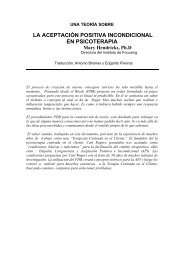8 Focusing en de experiëntiële aspecten van psychotherapie
8 Focusing en de experiëntiële aspecten van psychotherapie
8 Focusing en de experiëntiële aspecten van psychotherapie
You also want an ePaper? Increase the reach of your titles
YUMPU automatically turns print PDFs into web optimized ePapers that Google loves.
620 Literatuur<br />
Mearns, D., & Cooper, M. (2005). Working at relational <strong>de</strong>pth in counselling and psychotherapy. London:<br />
Sage.<br />
Mearns, D., & Thorne, B. (2000). Person-c<strong>en</strong>tered therapy with ‘Configurations’ of Self. In Person-c<strong>en</strong>-<br />
tered therapy today. New Frontiers in theory and practice (pp. 120-143). London: Sage.<br />
Mearns, D., & Thorne, B. (2007). Person-c<strong>en</strong>tred counselling in action (3 rd ed.). London: Sage.<br />
Merleau-Ponty, M. (1962). The ph<strong>en</strong>om<strong>en</strong>ology of perception. London: Routledge.<br />
Merry, T. (2001). Congru<strong>en</strong>ce and the supervision of cli<strong>en</strong>t-c<strong>en</strong>tred therapists. In G. Wyatt (Red.), Rogers’<br />
therapeutic conditions: Evolution, theory and practice. Vo1. 1. Congru<strong>en</strong>ce (pp. 174-183). Ross-on-Wye,<br />
UK: PCCS Books.<br />
Merry, T. (2002). Learning and being in person-c<strong>en</strong>tred counselling (2nd ed.). Ross-on-Wye, UK: PCCS<br />
Books.<br />
Meurs, P., & Leijss<strong>en</strong>, M. (1997). Psychoanalytische kin<strong>de</strong>rtherapie, e<strong>en</strong> boei<strong>en</strong><strong>de</strong> ontmoetingsplaats<br />
voor het cliëntgericht-experiëntieel mo<strong>de</strong>l. Tijdschrift Cliëntgerichte Psychotherapie, 35, 229-256.<br />
Meyk<strong>en</strong>s, S., & Cluckers, G. (2000). Kin<strong>de</strong>rtek<strong>en</strong>ing<strong>en</strong> in ontwikkelingspsychologisch <strong>en</strong> diagnostisch<br />
perspectief. Leuv<strong>en</strong>/Amersfoort: Acco.<br />
Millon, T., & Davies, R. (1995). Conceptions of personality disor<strong>de</strong>rs: historical perspectives, the DSMs,<br />
and future directions. In W.J. Livesley (Red.), The DSM-IV personality disor<strong>de</strong>rs. New York: Guilford.<br />
Missia<strong>en</strong>, C. (2001). Cliëntgerichte groeps<strong>psychotherapie</strong>. Zes stelling<strong>en</strong> kritisch getoetst. Tijdschrift<br />
Cliëntgerichte Psychotherapie, 39, 84-96.<br />
Missia<strong>en</strong>, C., Wollants, G., Lietaer, G., & Gundrum, M. (2000). Gloria-Rogers on<strong>de</strong>r experiëntieel vergrootglas.<br />
Tijdschrift voor Gestalttherapie, 7(7), 19-42.<br />
Moerland, K. (1993). Specifieke indicatiecriteria voor cli<strong>en</strong>t-c<strong>en</strong>tered therapie. Amsterdam: Vrije Universiteit<br />
(doctoraalscriptie).<br />
Monograin, M., & Leather, F. (2006). Immature <strong>de</strong>p<strong>en</strong>d<strong>en</strong>ce and self-criticism predict the recurr<strong>en</strong>ce of<br />
major <strong>de</strong>pression. Journal of Clinical Psychology, 62, 705-713.<br />
Moon, K.A. (2004). Nondirective cli<strong>en</strong>t-c<strong>en</strong>tered therapy with childr<strong>en</strong>. In J.C. Watson, R.N. Goldman &<br />
M.S. Warner (Red.), Cli<strong>en</strong>t-c<strong>en</strong>tered and experi<strong>en</strong>tial psychotherapy in the 21st c<strong>en</strong>tury: Ad<strong>van</strong>ces in<br />
theory, research and practice (pp. 485- 492). Ross-on-Wye: PCCS Books.<br />
Moore, J. (2004). Letting go of who I think I am: list<strong>en</strong>ing to the unconditional self. Person-C<strong>en</strong>tered &<br />
Experi<strong>en</strong>tial Psychotherapies, 3, 117-128.<br />
Mor<strong>en</strong>o, J.L. (1934). Who shall survive? A new approach to the problem of human interrelations. Washington<br />
DC: Nervous and M<strong>en</strong>tal Disease Publishing.<br />
Mor<strong>en</strong>o, J.L. (1936). Organization of the social atom. Sociometric Review, 4, 10-13.<br />
Mor<strong>en</strong>o, J.L. (1939). Psychodramatic shock therapy: A sociometric approach to the problem of m<strong>en</strong>tal<br />
disor<strong>de</strong>rs (Psychodrama monograph No. 5). Beacon, NY: Beacon House.<br />
Mor<strong>en</strong>o, J.L., & Elefthery, D.G. (1982). An introduction to group psychodrama. In G.M. Gazda (Red.), Basic<br />
approaches to group psychotherapy and group counseling (pp. 101-135). Springfield, IL.: Charles C.<br />
Thomas.<br />
Mor<strong>en</strong>o, Z.T., Blomkvist, L.D., & Rützel, T. (2000). Psychodrama, surplus reality and the art of healing.<br />
London, Phila<strong>de</strong>lphia: Routledge.<br />
Mosher, J.L., Goldsmith, J.Z., Stiles, W.B., & Gre<strong>en</strong>berg, L.S. (2008). Assimilation of two critical voices in a<br />
person-c<strong>en</strong>tered therapy for <strong>de</strong>pression. Person-C<strong>en</strong>tered & Experi<strong>en</strong>tial Psychotherapies, 7, 1-19.<br />
Motschnig-Pitrik, R. & Lux, M. (2008). The person-c<strong>en</strong>tered approach meets neurosci<strong>en</strong>ce: Mutual support<br />
for C.R. Roger’s and A. Damasio’s theories. Journal of Humanistic Psychology, 48 (3), 287-319.<br />
Moustakas, C.E. (1997). Relationship play therapy. Northvale: Jason Aronson.










